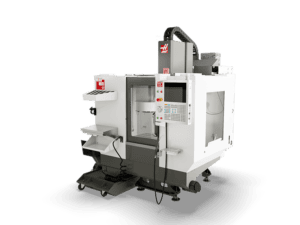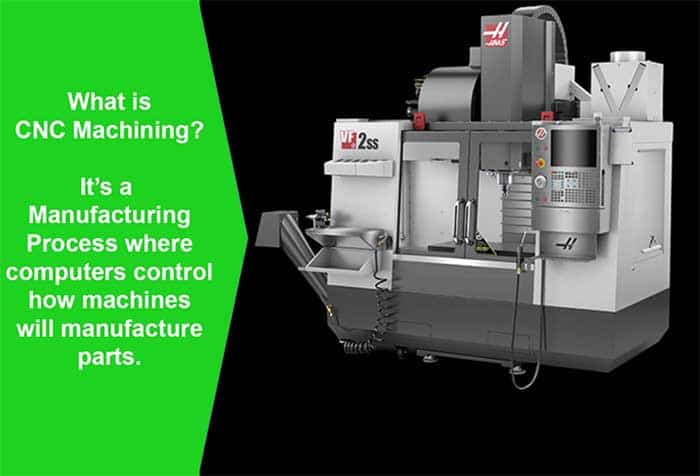
Key Takeaways
- CNC Machining Definition: CNC Machining is a manufacturing process where computers run programs that control how the machines will manufacture parts.
- CNC stands for Computer Numerical Control.
- There are many different kinds of CNC Machine including 3D Printers, CNC Mills, CNC Lathes, CNC Laser Cutters, Water Jets, Electronic Discharge Machines (EDM’s), CNC Routers, and more.
- A CNC Machine executes what are called “Part Programs” which are written in a special language called “G-Code.” A g-code part program may either be directly coded, or CAM Software (CAM stands for Computer Aided Manufacturing) may be used to convert a CAD drawing of the part into g-code. CAD is “computer-aided design”, software used to create the blueprints for the parts we’re making.
- The introduction of carbide to allow much faster cutting than HSS was the industry's first big machining productivity improvement. The second big productivity increase is replacing manual machines with CNC Machines.
CNC Machine Types
The main types of CNC Machine are:
CNC Milling Machine
CNC Milling machines move a spinning cutter through 3-5 dimensions.
CNC Lathe
CNC Lathes spin the workpiece and cut it with stationary cutters.
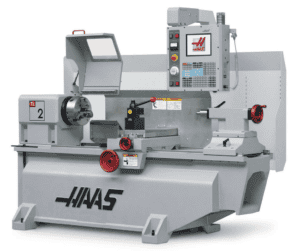
CNC Router
CNC Routers are similar to CNC Mills, but use a different geometry to facilitate work on flatter workpieces. They are often used to cut wood and plastics, but are also capable of cutting at least softer non-ferrous metals.
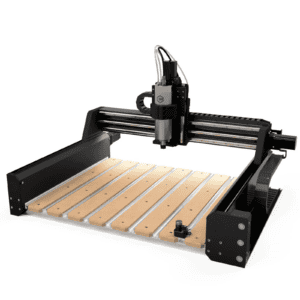
CNC Laser Cutter
CNC Laser Cutters rely on a laser beam to cut or engrave the materials they work on.
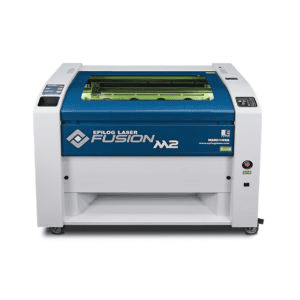
What Is CNC? (CNC Definition)
CNC Machining is a manufacturing process where computers run programs that control how the machines will manufacture parts. These CNC Programs using CNC Software can control everything from the motions the machine makes to spindle speed, turning coolant on or off, and much more.
The computer language used to program CNC Machines is a standardized programming language called "G-Code". To make it easier, g-code is seldom written by hand. Instead, visual programming tools called CAM Software are used to create the g-code. "CAM" stands for Computer Aided Manufacturing.
CNC Machining of parts is often chosen when manufacturing must result in high precision or quality, or when the materials are particularly tough and hard to work.
There are many different kinds of CNC Machine including 3D Printers, CNC Mills, CNC Lathes, CNC Laser Cutters, Water Jets, Electronic Discharge Machines (EDM's), CNC Routers, and more.
What Does CNC Stand For? What Does CNC Mean?
The cnc acronym stands for Computer Numerical Control.
It is an outgrowth of the older term "NC", which stands for "Numerical Control". It refers to the idea of controlling machine tools via computer. CNC Machines are robots of a sort.
With the older "NC" term, a computer need not be involved. The machine might be controlled using, for example, punched tape.
The NC Programs tell the machine the following types of things:
- How fast to turn the spindle
- How fast to move the cutter
- Direction to move the cutter in each axis (X, Y, and Z for 3 axis, and more for a 4 or 5-axis machine)
- What cutter to use if the machine has a tool changer
- When to turn coolant and or off (i.e. spray cooling fluid on the part during cutting)
And more.
The introduction of carbide to allow much faster cutting than HSS was the first big machining productivity improvement in the industry. The replacement of manual machines with CNC Machines is the second big productivity increase.
Computer Numerical Control Technology continues to make gains in productivity as time goes on. And now we've answered the question, "What does CNC mean?" from a couple of angles.
What Is a CNC Machine? (CNC Machine Definition)
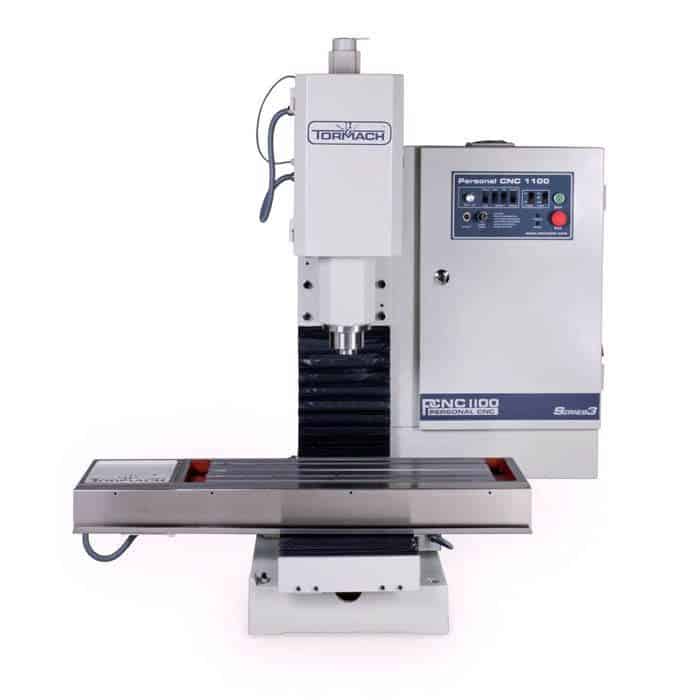
CNC machines are computer-controlled machine tools. Before CNC, machine tools were manually controlled by machinists.
On a manual machine, the machinist operates the machine by turning handwheels. With a CNC machine, a computer controls servos that operate the machine and guide it through the CNC Machining process. Essentially they are machining robots. NC, and later CNC, allowed for tremendous increases in productivity for machine tools because the machinery could be run automatically without requiring constant attention from their operator.
Before the advent of such automation, there was a simpler automation capability in the form of hydraulic tracer systems. Such systems used hydraulics to cause the cutting tools of a lathe or mill to follow or trace a template. There were also screw machines, whose automated functions where mechanically controlled by cams.
The taper attachments available for many manual lathes are not unlike the hydraulic tracer capability, it's just that the tracer is capable of more elaborate templates than simple tapers.
But the advent of first NC and then later CNC radically increased the amount of automation that was possible when manufacturing. CNC Machining is the dominant method of machining materials these days, though manual machining is still quite common as well for one-offs, repair, and prototyping work.
The individuals that run CNC Machinery on Shop Floors are called "CNC Operators," while those that write the programs to automate production are "CNC Programmers."
A CNC Machine executes what are called "Part Programs" which are written in a special language called "G-Code." A g-code part program may either be directly coded, or CAM Software (CAM stands for Computer Aided Manufacturing) may be used to convert a CAD drawing of the part into g-code. CAD is "computer aided design", software used to create the blueprints for the parts we're making.
For a long time, CNC Machines were strictly industrial machines because they cost many tens of thousands of dollars. Today, DIY CNC'ers build their own CNC machines as a hobby and there are also many fine machines available in price ranges that make it possible to own a CNC machine in a home shop.
The precision of CNC machinery is largely a function of the quality of the CNC machine. Machines designed for very high precision must be very high quality and are therefore quite expensive.
For a quick run down on how much does a CNC Machine cost, check out the linked article.
Ready to Learn More About CNC?
You need our CNC Beginner and DIY Cookbook. It is your guide to all the free resources, tutorials, and guides we have to help you learn CNC.
What Types of CNC Machines Exist?
The short answer is more than we could possibly go into here, but let's try to cover some of the major categories of the most common types of CNC Machines. The biggest categories of CNC Machine are CNC Milling Machines, CNC Lathes, CNC Routers, CNC Laser Cutters, Wire EDM Machine, and CNC Plasma Cutters.
You'll find these machines can be somewhat specialized. For example, CNC Routers are often used for soft materials such as wood and plastics. CNC Plasma Cutters are exclusively used to cut metals that conduct electricity. A CNC Milling Machine will cut just about anything, and at a higher precision than most other CNC machines.
For a description of all the different CNC machine types see our article.
CNC Milling Machines
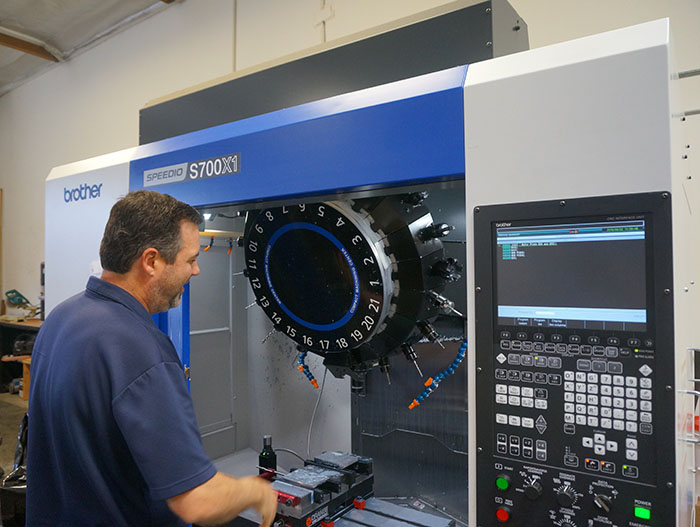
A typical CNC Milling Machine...
In a CNC Mill, the cutter is placed in the spindle where it rotates. The workpiece then moves past the cutter so that chips may be sliced off. The act of cutting a workpiece on CNC Milling Machines is called "Milling".
Basic CNC Mill Operation. More advanced CNC Mills are called "Vertical Machining Centers"...
CNC Mills have at the very least the ability to cut in 3 dimensions (some older machines may be limited to 2 or 2 1/2 if there are limitations on when that 3rd dimension may be used) which are referred to as the X, Y, and Z axes. Each axis is controlled by a servo or stepper motor that is triggered by the CNC Control.
The most elaborate CNC Milling Machines are called "Machining Centers." For example, there are Vertical Machining Centers (VMC's) and Horizontal Machining Centers (HMC's). The vertical and horizontal refer to whether the axis parallel to the spindle (typically "Z") is vertical or horizontal.
One of the essential capabilities of machining centers is their use of an Automatic Tool Changer (ATC), which lets them manage and automatically switch between multiple tools.
CNC Mills may allow the cnc machinist to access as many as 5 dimensions. CNC Systems with that level of capability are complex machinery that will obviously be at the more expensive end of the spectrum. They will require CAD software and Computer Aided Manufacturing CAM software that is more capable as well.
CNC Lathes
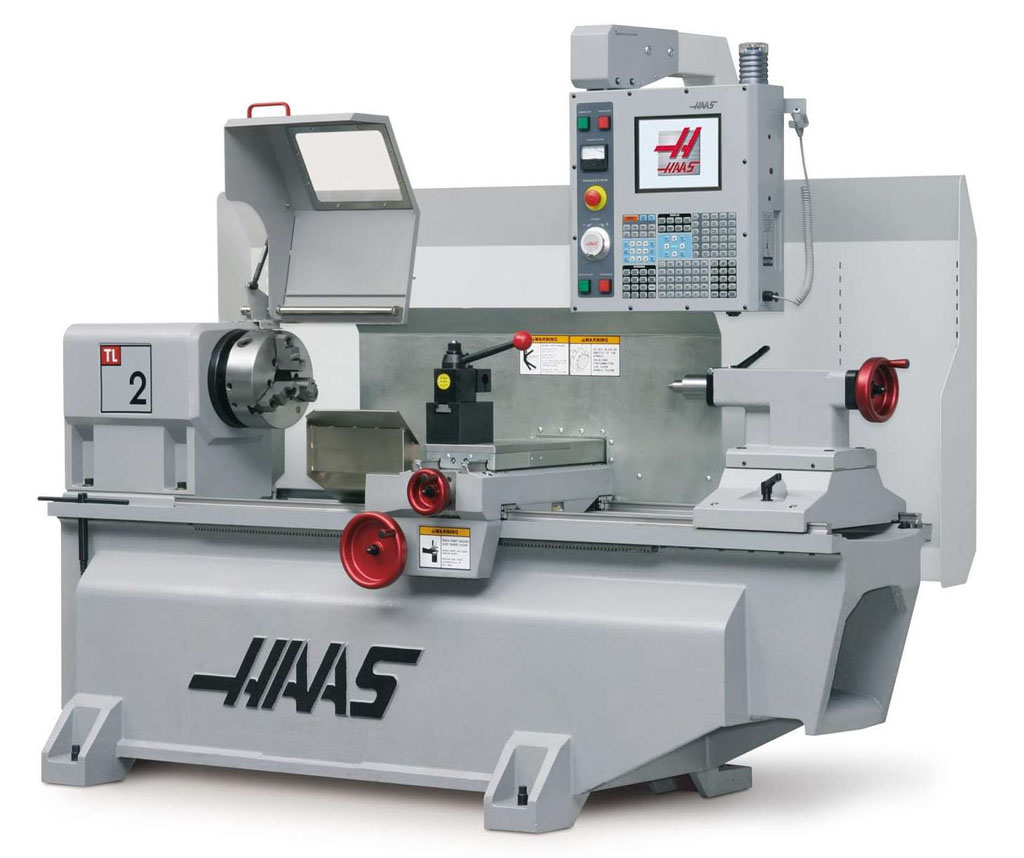
Typical CNC Lathe, the Haas TL-1...
Some view Lathes as the only universal CNC Machine because a CNC lathe can make all of the parts needed for another lathe.
A CNC lathe spins the workpiece in a spindle while a fixed cutting tool approaches the workpiece to slice chips off of it. Because of this geometry, lathes are ideal for parts that have symmetry around some axis that could be chucked up in the spindle. This orientation to round parts is also why the act of cutting is called "CNC Turning".
Making a Chess Rook on a CNC Lathe...
CNC Lathes have at the very least the ability to drive the cutting tool under g-code control over 2 axes, referred to as X and Z. They may have a considerable amount of other functionality as well, and there are many variations on lathes such as Swiss Lathes.
The act of cutting a workpiece on a lathe is called "CNC Turning". The more heavy featured CNC Lathes are called "Turning Centers". A Turning Center typically has a full enclosure and a tool changer, usually called a "Turret" on a lathe, but there are also "Gang" tool lathes.
A more advanced Turning Center may have the ability to mill as well. To do this, the spindle axis must operate as a servo so it can be precisely positioned at a particular angle. Turning Centers that can act as milling machines are called Mill-Turn Machines.
A Mill-Turn Machine can be very efficient at production if it is equipped with a bar puller or bar feeder. Raw materials in the form of bars are loaded on and the machine automatically processes them to produce finished or nearly finished parts. A Mill-Turn machine requires little supervision or manual control, which gives them a higher degree of automation than most cnc mills. If the CNC Lathe manufacturing process will work for your parts, you can produce them at low costs due to the higher degree of automation.
All of these added capabilities make a CNC Lathe far more powerful tools than most manual lathes. CNC technology can add considerable value!
CNC Routers
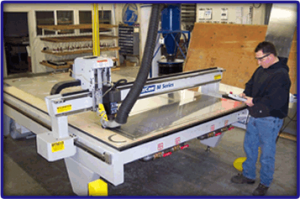
CNC Router...
A CNC Router is actually a type of CNC Mill, typically one that uses what's called a "gantry" configuration. These are the premier wood cnc machine. They're called CNC Routers instead of CNC Gantry Mills when they're used to cut wood, but this need not exclusively be the case.
A typical CNC Router is usually not capable of as much precision as a CNC Mill. They sacrifice some precision in the name of a larger work envelope with the gantry design of a CNC Router.
Cutting a raised panel door in seconds with commercial CNC Router...
Many think of CNC machines as being focused on cutting metal (often via CNC Milling Machine), but there is a huge market for CNC woodworking machines (CNC Routers) too. A CNC Router is ideally suited to machining sheet goods like plywood that are too large for the average CNC Mill.
For a deep comparison of CNC Routers vs Mills, see our stand-alone article. It will give you an idea of which manufacturing process will better suit your needs.
CNC Laser Cutters
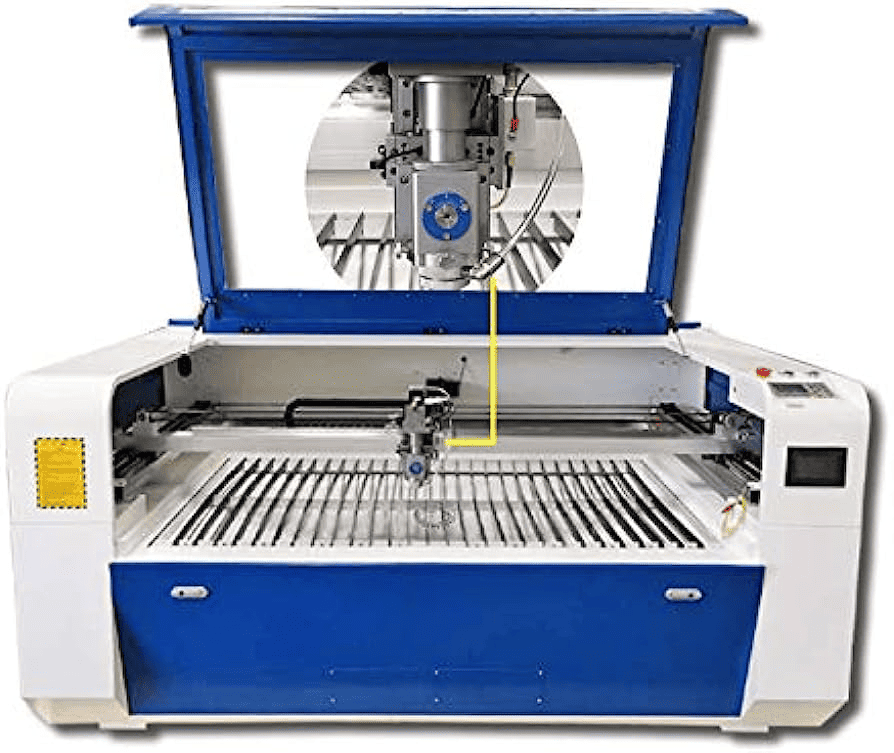
A CNC Laser Cutting Machine…
A CNC Laser Cutter is similar to a CNC Router, but with the rotating spindle replaced by a laser.
There are many more types of CNC machine than just these most common types including CNC presses of various kinds for fabrication, Plasma Tables, EDM machines, water jet cutters, and so on.
Ready to Learn More About CNC?
You need our CNC Beginner and DIY Cookbook. It is your guide to all the free resources, tutorials, and guides we have to help you learn CNC.
Desktop CNC Machines (Hobby vs Industrial)
For many of the main cnc machine types there are inexpensive hobby versions available. There is a thriving market for DIY CNC'ers.
These hobby machines are not as fast or accurate as an industrial cnc machine tool, but nonetheless they allow hobbyists to do amazing work. The most common CNC Machines used by hobbyists are CNC Routers and 3D Printers. It's even possible to start a small business with a hobby scale CNC Router, so don't underestimate the potential of such machines.
CNC Machining Process - How Do CNC Machines Make Parts?
The cnc machining process is pretty straightforward, and involves the following steps (for greater detail on a step, click through the link):
-
1
Design Idealized Part ▶
-
Use CAD software to design a 2D or 3D model of the part you want to make. CAD stands for "Computer Aided Drafting", so CAD software is like drawing software that lets you precisely specify the dimensions of your part.
-
2
CNC Programming ▶
-
Use CAM software to convert the CAD model into g-code. G-Code is the language used to program a CNC Machine. You can learn more about it in our Free G-Code Programming Course, one of our easy tutorials.
-
3
Machine Setup ▶
-
In this step, the machine is set up with workholding, proper tooling, and the g-code program and tool data are loaded to prepare the machine to manufacture the part. The operator will also tell the machine where part zero is. Part Zero is the axis position that corresponds to 0, 0, 0 in the CAD model of the part.
-
4
Machine the Part
-
With everything set up, it's time to machine the part.
This description is simplified. For a lot more detail, see our in-depth article on How to Make CNC Parts
How Can I Get Started With CNC?
Given the basic history of CNC and an overview of the major CNC Machines, what does one need to know to get started with CNC?
Knowledge in a number of different areas will be helpful. For example, basic machining skills are pretty important. A CNC machine starts from basic machining principles, although it can automate operations that are flat out impossible for a manual human machinist to perform by turning handwheels. A good starter article on the basics of CNC Machining can be found here. That article walks through the steps involved in the cnc machining process and lets you drill down for more information on each step.
A knowledge of some electronics, principally around motion control applications is helpful as well, since CNC Machines involve quite a lot of electronics in addition to their mechanical aspects. We have several articles related to the type of electronics knowledge needed for CNC in our site's Cookbook section.
Since "What does CNC stand for?" is answered "Computer Numerical Control", obviously computers are important. But specifically, computer software that's used with CNC. There are a few different kinds.
The programs that run CNC machine tools are called "part programs." Before we can get very far, we must understand how to create and use CNC part programs, which are written in some dialect of G-Code. Here again, CNCCookbook offers a free tutorial course that teaches how to read and write the G-Code.
Having gotten this far, the aspiring CNC machinist will be realizing that there is quite a lot of specialized CNC Software. Here are four of the most common types of CNC software:
- CNC Calculators to help calculate Feeds and Speeds. Check out our G-Wizard CNC Calculator for example.
- CNC Program Editors to help us manage g-code. Try our G-Wizard Editor.
- CAD programs used to create drawings and 3D models of the parts we want to machine.
- CAM programs that start from a CAD drawing and produce the g-code our CNC machines execute.
There are many more types of CNC software out there. For a survey of all the different varieties, check out our article, "CNC Software: Digital Tooling for CNC".
Lastly, if you're interested in hobby-scale CNC machines, we have an article that takes you through what types of cnc machines are available to hobbyists and DIY'ers.
Any of the links in the last section will give you more material to chew on as you get started learning more about CNC.
CNC Software for Beginners
A big part of CNC is the software. If you're ready to take the plunge and move beyond reading about the possibilities, start with our Guide to the Best CNC Software for Beginners.
We've worked hard to put together the best buying guides, evaluation tips, and even guides to secret smokin' deals that let you buy the most popular software for unheard of prices. Check it out!
So You Want to Be a CNC Machinist?
Let's put aside the hobby potential and explore what it takes to become a professional CNC Machinist.
There are a number of skills you'll need to learn:
- Machine Setup and Machining Operation: These are the basics of how to set up a CNC machine to run a job making one or more parts. Once you've mastered this skill, you're qualified to be a CNC Operator. A CNC Operator is not yet a full fledged CNC Machinist, but it is a real job you can be paid to do.
- Fixturing and Work holding: Part of any CNC Job is how you're going to hold the workpiece so you can access as many sides as are needed. This is one of the areas that sets the truly skilled cnc machinists apart from the more average.
- Cutting Tools and Other Tooling: Understand all the ins and outs of the cutting tools as well as their feeds and speeds is another essential step for a cnc machinist. Each major category of tool has a fair bit of knowledge associated with it. For example, Face Mills are an important area of expertise.
- CNC Programming: We've mentioned the software aspects of the job before. A thorough understanding of Computer Aided Design (CAD) and Computer Aided Manufacturing CAM are essential for any CNC Machinist. There's quite a lot to know such as the ins and outs of the various tool paths your software supports. If you get really good at it, you can be considered a cnc programmer, which is a whole other job description.
- Preventative Maintenance and Shop Operations.
- Job Quoting is a big deal and is definite a skill to consider learning.
- Metrology and Inspecting. Precision measuring is another big area to learn about and understand.
- Manufacturing Processes: If you've got one process down, you'll find more processes are useful to broaden your capabilities. Most CNC Machinists will start with milling or turning (lathe) operations. But there are many other manufacturing processes ranging from the mundane to the very exotic-Electron Beam Machining, anyone? Or how about Ultrasonic Machining?
The manufacturing industry can be very rewarding, and CNC is one of those areas where you can never learn everything. Best to just never stop learning, then.
A Short History of CNC
The first commercial NC machines were built in the 1950's, and ran from punched tape. While the concept immediately proved it could save costs, it was so different that it was very slow to catch on with manufacturers.
In order to promote more rapid adoption, the US Army bought 120 NC machines and loaned them to various manufacturers so they could become more familiar with the idea of numerical control. By the end of the 50's, NC was starting to catch on, though there were still a number of issues.
For example, g-code, the nearly universal language of CNC we have today, did not exist. Each manufacturer was pushing its own language for defining numerical control or part programs (the programs the machine tools would execute to create a part).
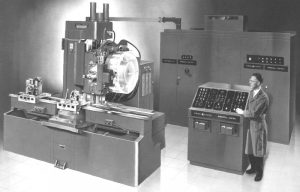
1959 CNC Machine: Milwaukee-Matic-II was first machine with a tool changer...
A number of key developments brought CNC rapidly along during the 1960's:
- Standard G-Code Language for Part Programs: The origin of g-code dates back to MIT, around 1958, where it was a language used in the MIT Servomechanisms Laboratory. The Electronic Industry Alliance standardized g-code in the early 1960's.
- CAD came into its own and started rapidly replacing paper drawings and draftsmen during the 60's. By 1970, CAD was a decent sized industry with players like Intergraph and Computervision, both of whom I consulted for back in my college days.
- Minicomputers like the DEC PDP-8's and Data General Nova's became available in the 60's and made CNC machines both cheaper and more powerful.
By 1970, the economies of most Western countries had slowed and employment costs were rising. With the 60's, having provided the firm technology foundation that was needed, CNC took off and began steadily displacing older technologies such as hydraulic tracers and manual machining.
US companies had largely launched the CNC revolution, but they had been overly focused on the high end. The Germans were the first to see the opportunity to reduce prices of CNC, and by 1979 the Germans were selling more CNC than the US companies. The Japanese repeated the same formula to an even more successful degree and had taken the leadership away from the Germans just one year later, by 1980. In 1971, the 10 largest CNC companies were all US companies, but by 1987, only Cincinnati Milacron was left and they were in 8th place.
More recently, microprocessor technology has made CNC controls even cheaper, culminating with the availability of CNC for the hobby and personal CNC market.
Affordable CNC machinery also paved the way for CNC use in prototyping, along with 3D Printing. Earlier, the use of CNC was confined primarily to production shops.
The Enhanced Machine Controller project, or EMC2, was a project to implement an Open Source CNC controller that was started by NIST, the National Institute of Standards and Technology as a demonstration. Some time in 2000, the project was taken into the public domain and Open Source, and EMC2 appeared a short time later in 2003.
Mach3 was developed by Artsoft founder Art Fenerty as an offshoot of early EMC versions to run on Windows instead of Linux, making it even more accessible to the personal CNC market. Art's company, ArtSoft, was founded in 2001. The advent of Mach3 made CNC affordable outside industrial shops for the first time.
Both the EMC2 (now called LinuxCNC) and Mach3 CNC software programs are alive and thriving today, as are many other CNC technologies.
We've come a long ways since the old numerical control days!
Ready to Learn More About CNC?
You need our CNC Beginner and DIY Cookbook. It is your guide to all the free resources, tutorials, and guides we have to help you learn CNC.
Be the first to know about updates at CNC Cookbook
Join our newsletter to get updates on what's next at CNC Cookbook.
